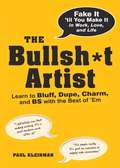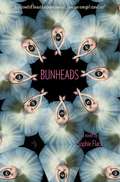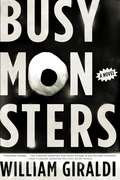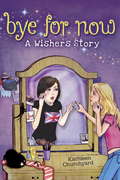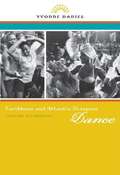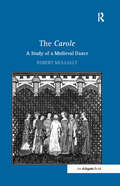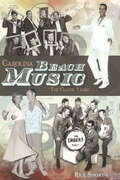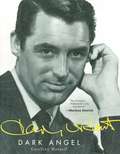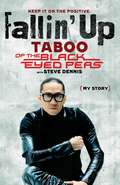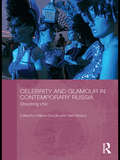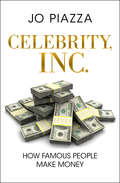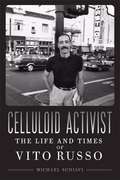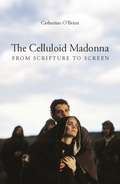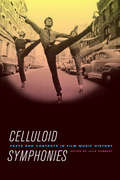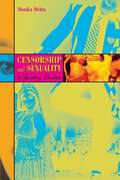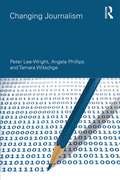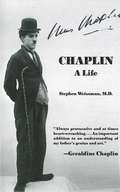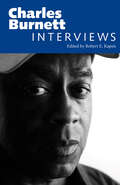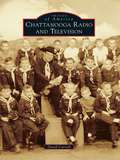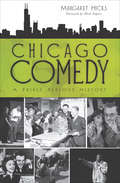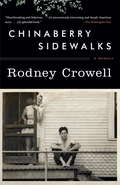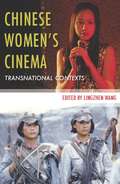- Table View
- List View
The Bullshit Artist
by Paul KleinmanIt's not what you know. It's what they think you know. And they will think you know it all once you learn how to bullsh*t successfully. Because there's a difference between talking out of your ass and bullsh*tting like a pro--and if you want to sound in the know without getting called out, you better know how to do it right. What you want is to be able to control any conversation and keep cool under pressure with a combination of confidence and cunning. To help out, there's a section of useful facts to stick up your sleeve. Forget being a know-it-all. You'll tap into real appeal and have a lot more fun once you become a skilled bullsh*t artist. Guaranteed.
Bunheads
by Sophie FlackOn-stage beauty. Backstage drama. As a dancer with the ultra-prestigious Manhattan Ballet Company, nineteen-year-old Hannah Ward juggles intense rehearsals, dazzling performances and complicated backstage relationships. Up until now, Hannah has happily devoted her entire life to ballet. But when she meets a handsome musician named Jacob, Hannah's universe begins to change, and she must decide if she wants to compete against the other "bunheads" in the company for a star soloist spot or strike out on her own in the real world. Does she dare give up the gilded confines of the ballet for the freedoms of everyday life?
Busy Monsters
by William GiraldiEchoing a narrative line that includes Kurt Vonnegut and Joseph Heller, William Giraldi's Busy Monsters has been hailed as one of the most exciting fiction debuts in years. Penned with a linguistic bravado that explores the diaphanous line between fiction and fact, this "very funny, very inventive début novel" (The New Yorker) has at last revived the great American picaresque tradition.
Bye For Now: A Wishers Story
by Kathleen ChurchyardThe candles dripped onto the icing as Robin deliberated. What could she possibly wish? She wanted to wake up the next day and learn all her problems were gone. But since her problems weren’t going to disappear, she didn’t want to be Robin anymore. “I wish I was somebody else,” Robin wished. And in that moment, she meant it. She blew out the candles. After the worst eleventh birthday ever, Robin wakes up the next morning in the body of Fiona, an eleven-year-old girl from London with an amazing life. Fiona is gorgeous, with glamorous parents, and she’s the star of a major theatrical production. Why would Fiona have wished herself out of her own body? Slowly, Robin discovers a whole network of girls like her-girls who have gotten their wish and are living somebody else’s life. But what happens when Robin finally decides she wants to go home? Does anybody in the Wishers network know how to make this happen? In this exciting first novel, Kathleen Churchyard asks: What if you wished for someone else’s life-and it came true?
Caribbean and Atlantic Diaspora Dance: Igniting Citizenship
by Yvonne DanielIn Caribbean and Atlantic Diaspora Dance: Igniting Citizenship, Yvonne Daniel provides a sweeping cultural and historical examination of diaspora dance genres. In discussing relationships among African, Caribbean, and other diasporic dances, Daniel investigates social dances brought to the islands by Europeans and Africans, including quadrilles and drum-dances as well as popular dances that followed, such as Carnival parading, Pan-Caribbean danzas,rumba, merengue, mambo, reggae, and zouk. Daniel reviews sacred dance and closely documents combat dances, such as Martinican ladja, Trinidadian kalinda, and Cuban juego de maní. In drawing on scores of performers and consultants from the region as well as on her own professional dance experience and acumen, Daniel adeptly places Caribbean dance in the context of cultural and economic globalization, connecting local practices to transnational and global processes and emphasizing the important role of dance in critical regional tourism.
The Carole: A Study Of A Medieval Dance
by Robert MullallyThe carole was the principal social dance in France and England from c. 1100 to c. 1400 and was frequently mentioned in French and English medieval literature. However, it has been widely misunderstood by contributors in recent citations in dictionaries and reference books, both linguistic and musical. The carole was performed by all classes of society - kings and nobles, shepherds and servant girls. It is described as taking place both indoors and outdoors. Its central position in the life of the people is underlined by references not only in what we might call fictional texts, but also in historical (or quasi-historical) writings, in moral treatises and even in a work on astronomy. Dr Robert Mullally's focus is very much on details relevant to the history, choreography and performance of the dance as revealed in the primary sources. This methodology involves attempting to isolate the term carole from other dance terms not only in French, but also in other languages. Mullally's groundbreaking study establishes all the characteristics of this dance: etymological, choreographical, lyrical, musical and iconographical.
Carolina Beach Music: The Classic Years
by Rick SimmonsJust as the dances of Beach Music have their twists and turns, so too do the stories behind the hits made popular in shag haunts from Atlantic Beach to Ocean Drive and the Myrtle Beach Pavilion. In Carolina Beach Music, local author and Beach Music enthusiast Rick Simmons draws on first-hand accounts from the legendary performers and people behind the music. Simmons reveals the true meaning behind "Oogum Boogum," uncovers just what sparked a fistfight between Ernie K. Doe and Benny Spellman at the recording session of "Te-Ta-Te-Te-Ta-Ta," and examines hundreds of other true events that shaped the sounds of Beach Music.
Cary Grant: Dark Angel
by Geoffrey WansellHis signature jaw line and charismatic characters made him an American symbol. His films, including Bringing Up Baby, The Philadelphia Story, and North by Northwest, were timeless classics. However, Grant was also married five times and sustained a tortured, obsessive relationship with money. In this beautifully illustrated and comprehensive book, Geoffrey Wansell traces the threads of both light and darkness in one of Holly-wood's greatest stars. As his friend and co-star Deborah Kerr wrote, he was "one of the most outstanding personalities in the history of the cinema."
Cayendo hacia arriba: Mi historia
by Steve Dennis TabooTaboo, el artista ganador de premios Grammy y cofundador de los Black Eyed Peas, comparte la historia inspiradora de su ascenso desde las calles duras del este de Los Ángeles a la cumbre de la fama internacional.Pocos grupos pueden desear el tipo de éxito global alcanzado por los Black Eyed Peas, batiendo récords y vendiendo más de treinta millones de discos desde su formación en 1995. Desde su disco The E.N.D., que debutó como #1 en la lista de éxitos de Billboard, a The Beginning, los Black Eyed Peas continúan dominando la escena musical. El grupo recientemente rompió el récord sin precedentes con la estadía consecutiva en la posición #1 del Hot 100 List de Billboard, y su canción "I Gotta Feeling" se transformó en el primer sencillo en superar las seis millones de descargas digitales en los Estados Unidos. Pero en esta reveladora autobiografía--el primer libro que surge del grupo--Taboo nos recuerda que los grandes logros muchas veces vienen de comienzos humildes.Nacido en el este de Los Ángeles, en una zona conocida por las pandillas y la pobreza, Taboo vivía atormentado por ese entorno, el cual parecía que seguro determinaría su destino. Pero, encaminado por sus sueños de ser artista al joven Taboo se le abrió todo un universo cuando descubrió el mundo del hip-hop, donde el talento y el amor por la música en sí trascendió todo. Apoyado por su abuela Aurora, su única y ver- dadera defensora, Taboo persiguió sus sueños con una tenacidad implacable. Se negó a darse por vencido, sin importar lo que la vida le arrojara en su camino--incluyendo el ser padre a los dieciocho años.Pero incluso después de que los Black Eyed Peas vencieron posibilidades que parecían insuperables y lograron el estrellato, no todo fue Grammys y discos platinos. Taboo entrega un relato mordazmente honesto sobre su choque con los demonios de la fama, incluyendo su lucha con la drogadicción y el alcoholismo que casi acaban con su carrera. Pero, inspirado por el amor de su familia y nuevamente conectándose con el manantial de creencia en sí mismo que lo había sostenido en el pasado, Taboo aprende a controlar sus demonios y sus adicciones.Repleto de vistazos íntimos a los alcances más altos de la industria de la música--incluyendo una visita al castillo de Sting, un rato pasado con Bono y U2 y, a 41.000 pies, el karaoke de más alto vuelo nunca jamás--Cayendo hacia arriba lleva al lector por un viaje revelador y personal a través del estrellato, y el triunfo de un hombre sobre el doble de la adversidad.
Cayendo hacia arriba
by Taboo Steve DennisNow available in paperback, and for the first time in a Spanish-language edition, Grammy Award-winning singer and founding member of the Black Eyed Peas Taboo shares his inspiring story of his rise from the mean streets of East L.A. to the heights of international fame. Few bands can ever hope to achieve the sort of global success that the record-breaking Black Eyed Peas have attained, selling more than 30 million albums since their formation in 1995. But in this first book to emerge from the group, founding member Taboo reminds us that great accomplishments are often rooted in humble beginnings. Born in East L.A. in an area notorious for street gangs and poverty, Taboo was haunted by that environment which seemed certain to shape his destiny. Yet steered by his dreams to be a performer and assisted by fate, the young Taboo was "thrown a rope" when he discovered the world of hip-hop. Taboo chased his dreams with a relentless tenacity, refusing to surrender, regardless of what life threw at him--including becoming a father at age eighteen. Even after the Black Eyed Peas beat seemingly insurmountable odds and achieved stardom, it wasn't all Super Bowl performances, Grammys, and platinum albums. Taboo delivers a searingly honest account of his collision with fame's demons, including his almost career-ending struggle with drug addiction and alcoholism. But inspired by the love of his family and tapping anew into the wellspring of self-belief that had sustained him in the past, Taboo learns to keep his demons at bay, his addictions in check. Full of intimate glances into the highest reaches of the music industry, Fallin' Up takes readers on a revealing, personal journey through stardom--and one man's triumph over adversity times two.
Celebrity and Glamour in Contemporary Russia: Shocking Chic (BASEES/Routledge Series on Russian and East European Studies)
by Helena GosciloThis is the first book to explore the phenomenon of glamour and celebrity in contemporary Russian culture, ranging across media forms, disciplinary boundaries and modes of inquiry, with particular emphasis on the media personality. The book demonstrates how the process of ‘celebrification’ in Russia coincides with the dizzying pace of social change and economic transformation, the latter enabling an unprecedented fascination with glamour and its requisite extravagance; how in the 1990s and 2000s, celebrities - such as film or television stars - moved away from their home medium to become celebrities straddling various media; and how celebrity is a symbol manipulated by the dominant culture and embraced by the masses. It examines the primacy of the visual in celebrity construction and its dominance over the verbal, alongside the interdisciplinary, cross-media, post-Soviet landscape of today’s fame culture. Taking into account both general tendencies and individual celebrities, including pop-diva Alla Pugacheva and ex-President and current Prime Minister Vladimir Putin, the book analyses the internal dynamics of the institutions involved in the production, marketing, and maintenance of celebrities, as well as the larger cultural context and the imperatives that drive Russian society’s romance with glamour and celebrity.
Celebrity, Inc.: How Famous People Make Money
by Jo PiazzaFrom $10,000 tweets to making money in the afterlife, a recovering gossip columnist explores the business lessons that power the Hollywood Industrial Complex Why do celebrities get paid so much more than regular people to do a job that seems to afford them the same amount of leisure time as most retirees? What do Bush-era economics have to do with the rise of Kim Kardashian? How do the laws of supply and demand explain why the stars of Teen Mom are on the cover of Us Weekly? And how was the sale of Brad Pitt and Angelina Jolie&’s baby pictures a little like a street drug deal? After a decade spent toiling as an entertainment journalist and gossip columnist, Jo Piazza asks the hard questions about the business behind celebrity. Make no mistake: Celebrity is an industry. Never in the course of human history has the market for celebrities been as saturated as it is today. Nearly every day most Americans will consume something a celebrity is selling—a fragrance, a sneaker, a song, a movie, a show, a tweet, or a photo in a magazine. With the benefits of Piazza&’s unique access to the celebrity market, Celebrity, Inc. explains in detail what generates cash for the industry and what drains value faster than a starlet downs champagne—in twelve fascinating case studies that tackle celebrities the way industry analysts would dissect any consumer brand.
Celluloid Activist: The Life and Times of Vito Russo
by Michael SchiaviCelluloid Activist is the biography of gay-rights giant Vito Russo, the man who wrote The Celluloid Closet: Homosexuality in the Movies, commonly regarded as the foundational text of gay and lesbian film studies, and one of the first to be widely read. But Russo was much more than a pioneering journalist and author. A founding member of the Gay and Lesbian Alliance Against Defamation (GLAAD) and cofounder of the AIDS Coalition to Unleash Power (ACT UP), Russo lived at the center of the most important gay cultural turning points in the 1960s, 1970s, and 1980s. His life as a cultural Zelig intersects a crucial period of social change, and in some ways his story becomes the story of a developing gay revolution in America. A frequent participant at "zaps" and an organizer of Gay Activists Alliance (GAA) cabarets and dances-which gave the New York gay and lesbian community its first social alternative to Mafia-owned bars-Russo made his most enduring contribution to the GAA with his marshaling of "Movie Nights," the forerunners to his worldwide Celluloid Closet lecture tours that gave gay audiences their first community forum for the dissection of gay imagery in mainstream film. Biographer Michael Schiavi unravels Vito Russo's fascinating life story, from his childhood in East Harlem to his own heartbreaking experiences with HIV/AIDS. Drawing on archival materials, unpublished letters and journals, and more than two hundred interviews, including conversations with a range of Russo's friends and family from brother Charlie Russo to comedian Lily Tomlin to pioneering activist and playwright Larry Kramer,Celluloid Activist provides an unprecedented portrait of a man who defined gay-rights and AIDS activism.
The Celluloid Madonna: From Scripture to Screen (Wallflower Press Ser.)
by Catherine O'BrienThe Celluloid Madonna is the first book to analyze the life of the Virgin Mary on screen from the silent era through to the present. For decades, Mary has caught the imagination of filmmakers from a range of religious backgrounds, whether Catholic, Protestant, Muslim, Marxist, or atheist, and film's intersection of theology and secular culture has inspired some of the most singular and controversial visions of this icon in cinema history. Focusing on the challenge of adapting Scripture to the screen, this volume discusses Cecil B. DeMille's The King of Kings (1927), Pier Paolo Pasolini's The Gospel According to St. Matthew (1964), Franco Zeffirelli's Jesus of Nazareth (1977), Jean-Luc Godard's Hail Mary (1984), Jean Delannoy's Mary of Nazareth (1994), Mel Gibson's The Passion of the Christ (2004), Catherine Hardwicke's The Nativity Story (2006), and Mark Dornford-May's Son of Man (2006).
The Celluloid Madonna: From Scripture to Screen
by Catherine O'BrienThe Celluloid Madonna is the first book to analyze the life of the Virgin Mary on screen from the silent era through to the present. For decades, Mary has caught the imagination of filmmakers from a range of religious backgrounds, whether Catholic, Protestant, Muslim, Marxist, or atheist, and film's intersection of theology and secular culture has inspired some of the most singular and controversial visions of this icon in cinema history. Focusing on the challenge of adapting Scripture to the screen, this volume discusses Cecil B. DeMille's The King of Kings (1927), Pier Paolo Pasolini's The Gospel According to St. Matthew (1964), Franco Zeffirelli's Jesus of Nazareth (1977), Jean-Luc Godard's Hail Mary (1984), Jean Delannoy's Mary of Nazareth (1994), Mel Gibson's The Passion of the Christ (2004), Catherine Hardwicke's The Nativity Story (2006), and Mark Dornford-May's Son of Man (2006).
Celluloid Symphonies
by Julie HubbertCelluloid Symphonies is a unique sourcebook of writings on music for film, including essays by those who created the music: Max Steiner, Erich Korngold, Henry Mancini, Jerry Goldsmith, Elmer Bernstein and Howard Shore. Bringing together previously inaccessible critical documents, the book also describes the major trends and innovations that have shaped film music history from 1896 to the present. It outlines the important aesthetic choices, technological innovations, and commercial pressures that have consistently shaped the relationship between music and film. Julie Hubbert's introductory essays provide a stimulating overview of film history as well as critical context for the close study of these primary documents. In identifying documents that comprise a written and aesthetic history for film music, Celluloid Symphonies enriches the discourse of a broad community of film and music scholars and provides an astonishing resource to students.
Censorship and Sexuality in Bombay Cinema
by Monika MehtaIndia produces an impressive number of films each year in a variety of languages. Here, Monika Mehta breaks new ground by analyzing Hindi films and exploring the censorship of gender and heterosexuality in Bombay cinema. She studies how film censorship on various levels makes the female body and female sexuality pivotal in constructing national identity, not just through the films themselves but also through the heated debates that occur in newspapers and other periodicals. The standard claim is that the state dictates censorship and various prohibitions, but Mehta explores how relationships among the state, the film industry, and the public illuminate censorship's role in identity formation, while also examining how desire, profits, and corruption are generated through the act of censoring. Committed to extending a feminist critique of mass culture in the global south, Mehta situates the story of censorship in a broad social context and traces the intriguing ways in which the heated debates on sexuality in Bombay cinema actually produce the very forms of sexuality they claim to regulate. She imagines afresh the theoretical field of censorship by combining textual analysis, archival research, and qualitative fieldwork. Her analysis reveals how central concepts of film studies, such as stardom, spectacle, genre, and sound, are employed and (re)configured within the ambit of state censorship, thereby expanding the scope of their application and impact.
Changing Journalism (Communication and Society)
by Tamara Witschge Angela Phillips Peter Lee-WrightJournalism is in transition. Irrevocable decisions are being made, often based on flimsy evidence, which could change not only the future of journalism, but also the future of democracy. This book, based on extensive research, provides the opportunity to reflect upon these decisions and considers how journalism could change for the better and for the good of democracy. It covers: the business landscape work and employment the regulatory framework audiences and interaction the impact of technology on practices and content ethics in a converged world The book analyses research in both national and local journalism, broadcast, newspaper and online journalism, broadsheet and tabloid, drawing comparisons between the different outlets in the field of news journalism, making this essential reading for scholars and students of journalism and media studies.
Chaplin: A Life
by Stephen Weissman"Chaplin is arguably the single most important artist produced by the cinema," wrote film critic Andrew Sarris. Born in London in 1889, Charlie Chaplin grew up in dire poverty. Severe alcoholism cut short his father's flourishing career, and his beloved mother first lost her voice, then her mind, to syphilis. How did this poor, lonely child, committed to the Hanwell School for the Orphaned and Destitute, become such an extraordinary comedian, known and celebrated worldwide? Dr. Stephen M. Weissman brilliantly illuminates both the screen legend himself and the turbulent era that shaped him.
Charles Burnett: Interviews (Conversations with Filmmakers Series)
by Robert E. KapsisCharles Burnett (b. 1944) is a groundbreaking African American filmmaker and one of this country’s finest directors, yet he remains largely unknown. His films, most notably Killer of Sheep (1977) and To Sleep with Anger (1990), are considered classics, yet few filmgoers have seen them or heard of Burnett. The interviews in this volume explore this paradox and collectively shed light on the work of a rare film master whose stories bring to the screen the texture and poetry of life in the black community.The best qualities of Burnett’s films-rich characterizations, morally and emotionally complex narratives, and intricately observed tales of African American life-are precisely the things that make his films a tough sell in the mass marketplace. As many of the interviews reveal, Hollywood has been largely inept in responding to this marketing challenge. “It takes an extraordinary effort to keep going,” Burnett told Terrence Rafferty in 2001, “when everybody’s saying to you, ‘No one wants to see that kind of movie,’ or ‘There’s no black audience.’” All the interviews selected for this volume—spanning more than three decades of Burnett’s directorial career, including his recent work—examine, in various degrees, Burnett’s status as a true independent filmmaker and explore his motivation for making films that chronicle the black experience in America.
Chattanooga Radio and Television (Images of America)
by David CarrollTo those born and raised in Chattanooga, certain names bring a smile to their faces: Miss Marcia, Bob Brandy, Mort Lloyd, Dr. Shock, and, of course, "Luther." These are among the icons of Chattanooga broadcasting. They are the faces and voices that awakened Chattanoogans each morning, delivered the news, or made them laugh. Ever since two high school pals put the city's first radio station on the air in 1925, Chattanooga has been blessed with an abundance of memorable personalities. Some passed through on their way to national fame, while others have made Chattanooga their home for more than half a century.
Chicago Comedy: A Fairly Serious History
by Margaret Hicks&“An overview of Chicago&’s comedic legacy, from its early days . . . to its present day position as a breeding ground for some of comedy&’s biggest names&” (Gapers Block). Famous for being a city of broad shoulders, Chicago has also developed an international reputation for split sides and slapped knees. Watch the Chicago style of comedy evolve from nineteenth-century vaudeville, through the rebellious comics of the fifties and into the improvisation and sketch that ushered in a new millennium. Drawing on material both hilarious and profound, Second City alum Margaret Hicks touches on what makes Chicago different from other cities and how that difference produced some of the greatest minds comedy will ever know: Amos &‘n&’ Andy, Jack Benny, Lenny Bruce, Del Close, John Belushi, Tina Fey, Stephen Colbert and so many, many more. Includes photos!
Chinaberry Sidewalks
by Rodney CrowellFrom the acclaimed musician comes a tender, surprising, and often uproarious memoir about his dirt-poor southeast Texas boyhood. The only child of a hard-drinking father and a Holy Roller mother, Rodney Crowell was no stranger to bombast from an early age, whether knock-down-drag-outs at a local dive bar or fire-and-brimstone sermons at Pentecostal tent revivals. He was an expert at reading his father's mercurial moods and gauging exactly when his mother was likely to erupt, and even before he learned to ride a bike, he was often forced to take matters into his own hands. He broke up his parents' raucous New Year's Eve party with gunfire and ended their slugfest at the local drive-in (actual restaurants weren't on the Crowells' menu) by smashing a glass pop bottle over his own head. Despite the violent undercurrents always threatening to burst to the surface, he fiercely loved his epilepsy-racked mother, who scorned boring preachers and improvised wildly when the bills went unpaid. And he idolized his blustering father, a honky-tonk man who took his boy to see Hank Williams, Jerry Lee Lewis, Carl Perkins, and Johnny Cash perform live, and bought him a drum set so he could join his band at age eleven. Shot through with raggedy friends and their neighborhood capers, hilariously awkward adolescent angst, and an indelible depiction of the bloodlines Crowell came from, Chinaberry Sidewalks also vividly re-creates Houston in the fifties: a rough frontier town where icehouses sold beer by the gallon on paydays; teeming with musical venues from standard roadhouses to the Magnolia Gardens, where name-brand stars brought glamour to a place starved for it; filling up with cheap subdivisions where blue-collar day laborers could finally afford a house of their own; a place where apocalyptic hurricanes and pest infestations were nearly routine. But at its heart this is Crowell's tribute to his parents and an exploration of their troubled yet ultimately redeeming romance. Wry, clear-eyed, and generous, it is, like the very best memoirs, firmly rooted in time and place and station, never dismissive, and truly fulfilling.
Chinese Women’s Cinema: Transnational Contexts (Film and Culture Series)
by Lingzhen WangThe first of its kind in English, this collection explores twenty one well established and lesser known female filmmakers from mainland China, Hong Kong, Taiwan, and the Chinese diaspora. Sixteen scholars illuminate these filmmakers' negotiations of local and global politics, cinematic representation, and issues of gender and sexuality, covering works from the 1920s to the present. Writing from the disciplines of Asian, women's, film, and auteur studies, contributors reclaim the work of Esther Eng, Tang Shu Shuen, Dong Kena, and Sylvia Chang, among others, who have transformed Chinese cinematic modernity.Chinese Women's Cinema is a unique, transcultural, interdisciplinary conversation on authorship, feminist cinema, transnational gender, and cinematic agency and representation. Lingzhen Wang's comprehensive introduction recounts the history and limitations of established feminist film theory, particularly its relationship with female cinematic authorship and agency. She also reviews critiques of classical feminist film theory, along with recent developments in feminist practice, altogether remapping feminist film discourse within transnational and interdisciplinary contexts. Wang's subsequent redefinition of women's cinema, and brief history of women's cinematic practices in modern China, encourage the reader to reposition gender and cinema within a transnational feminist configuration, such that power and knowledge are reexamined among and across cultures and nation-states.
Chinese Women's Cinema: Transnational Contexts
by Lingzhen WangThe first of its kind in English, this collection covers twenty one well established and lesser known female filmmakers from mainland China, Hong Kong, Taiwan, and the Chinese diaspora. Sixteen scholars illuminate these filmmakers' negotiations of local and global politics, cinematic representation, and issues of gender and sexuality, covering works from the 1920s to the present. Writing from the disciplines of film, Asian, women's, and auteur studies, contributors reclaim the work of Esther Eng, Tang Shu Shuen, Dong Kena, and Sylvia Chang, among others who have transformed Chinese cinematic modernity. This collection creates a unique transcultural, interdisciplinary conversation on authorship, feminist cinema, transnational gender, and cinematic agency and representation. Lingzhen Wang's comprehensive introduction recounts the history and limitations of established feminist film theory, particularly its relationship with female cinematic authorship and agency. She also reviews critiques of classical feminist film theory, along with recent developments in feminist practice, ultimately remapping feminist film discourse within transnational and interdisciplinary contexts. Wang's subsequent redefinition of women's cinema and brief history of women's cinematic practices in modern China encourage the reader to reposition gender and cinema within a transnational feminist configuration, especially in such a way that power and knowledge are reexamined among and across cultures and nation-states.
